NISSAN ROGUE 2008 1.G Owner's Guide
Manufacturer: NISSAN, Model Year: 2008, Model line: ROGUE, Model: NISSAN ROGUE 2008 1.GPages: 309, PDF Size: 4.38 MB
Page 31 of 309

Black plate (30,1)
Model "S35-D" EDITED: 2007/ 12/ 19
SSS0800
Attaching rear center seat belt:
Always be sure the rear center seat belt
connector tongue and connector buckle are
attached. Disconnect only when folding down
the rear seat.
To connect the buckle:
1. Pull out the connector tongue from the
retractor base
*1.
2. Pull out the seat belt tongue from the
retractor base
*2.
3. Pull the seat belt and secure the connector
buckle until it clicks*3.
The center seat belt connector tongue can be
attached only into the rear center seat belt
connector buckle.
To fasten the seat belt, see “Fastening the seat
belts” earlier in this section.
WARNING
.Do not unfasten the rear center seat
belt connector except when folding
down the rear seat.
.When attaching the rear center seat
belt connector, be certain that the
seatbacks are completely secured in
the latched position and the rearcenter seat belt connector is com-
pletely secured.
.If the rear center seat belt connector
and the seatbacks are not secured
in the correct position, serious per-
sonal injury may result in an acci-
dent or sudden stop.
SEAT BELT EXTENDERSIf, because of body size or driving position, it is
not possible to properly fit the lap-shoulder belt
and fasten it, an extender is available that is
compatible with the installed seat belts. The
extender adds approximately 8 in (200 mm) of
length and may be used for either the driver or
front passenger seating position. See a NISSAN
dealer for assistance if an extender is required.
WARNING
.Only NISSAN seat belt extenders,
made by the same company which
made the original equipment seat
belts, should be used with NISSAN
seat belts.
.Adults and children who can use the
standard seat belt should not use an
extender. Such unnecessary use
could result in serious personal
1-18
Safety — Seats, seat belts and supplemental restraint system
Page 32 of 309
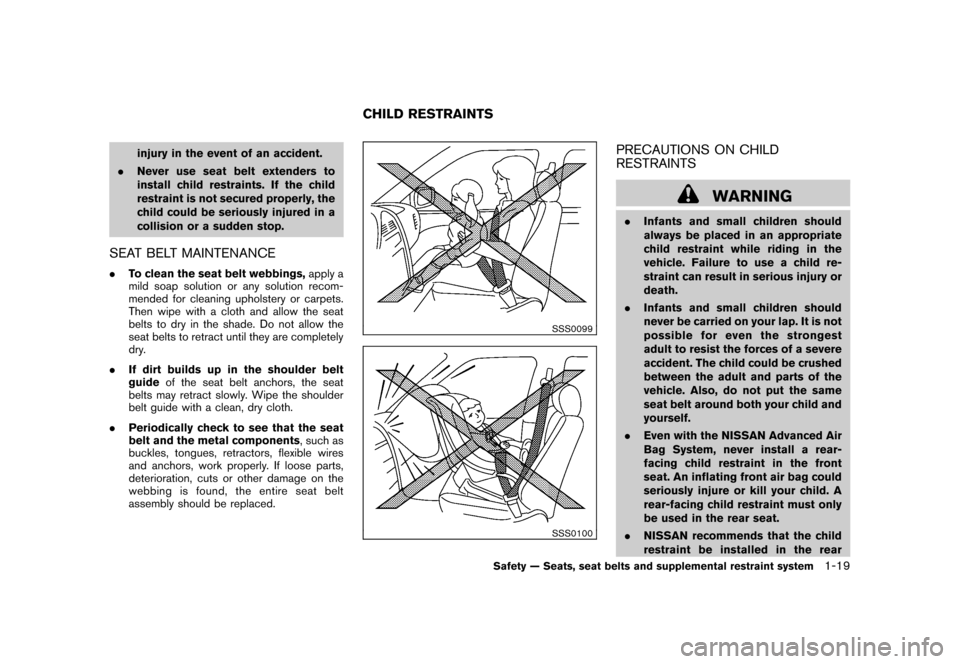
Black plate (31,1)
Model "S35-D" EDITED: 2007/ 12/ 19
injury in the event of an accident.
.Never use seat belt extenders to
install child restraints. If the child
restraint is not secured properly, the
child could be seriously injured in a
collision or a sudden stop.
SEAT BELT MAINTENANCE.To clean the seat belt webbings,apply a
mild soap solution or any solution recom-
mended for cleaning upholstery or carpets.
Then wipe with a cloth and allow the seat
belts to dry in the shade. Do not allow the
seat belts to retract until they are completely
dry.
.If dirt builds up in the shoulder belt
guideof the seat belt anchors, the seat
belts may retract slowly. Wipe the shoulder
belt guide with a clean, dry cloth.
.Periodically check to see that the seat
belt and the metal components, such as
buckles, tongues, retractors, flexible wires
and anchors, work properly. If loose parts,
deterioration, cuts or other damage on the
webbing is found, the entire seat belt
assembly should be replaced.
SSS0099SSS0100
PRECAUTIONS ON CHILD
RESTRAINTS
WARNING
.Infants and small children should
always be placed in an appropriate
child restraint while riding in the
vehicle. Failure to use a child re-
straint can result in serious injury or
death.
.Infants and small children should
never be carried on your lap. It is not
possible for even the strongest
adult to resist the forces of a severe
accident. The child could be crushed
between the adult and parts of the
vehicle. Also, do not put the same
seat belt around both your child and
yourself.
.Even with the NISSAN Advanced Air
Bag System, never install a rear-
facing child restraint in the front
seat. An inflating front air bag could
seriously injure or kill your child. A
rear-facing child restraint must only
be used in the rear seat.
.NISSAN recommends that the child
restraint be installed in the rear
CHILD RESTRAINTS
Safety — Seats, seat belts and supplemental restraint system
1-19
Page 33 of 309

Black plate (32,1)
Model "S35-D" EDITED: 2007/ 12/ 19
seat. According to accident statis-
tics, children are safer when prop-
erly restrained in the rear seat than
in the front seat. If you must install a
front facing child restraint in the
front seat, see “CHILD RESTRAINT
INSTALLATION USING THE SEAT
BELTS” later in this section.
.Improper use or improper installa-
tion of a child restraint can increase
the risk or severity of injury for both
the child and other occupants of the
vehicle and can lead to serious
injury or death in an accident.
.Follow all of the child restraint
manufacturer’s instructions for in-
stallation and use. When purchasing
a child restraint, be sure to select
one which will fit your child and
vehicle. It may not be possible to
properly install some types of child
restraints in your vehicle.
.If the child restraint is not anchored
properly, the risk of a child being
injured in a collision or a sudden
stop greatly increases.
.Child restraint anchor points are
designed to withstand only thoseloads imposed by correctly fitted
child restraints. Under no circum-
stances are they to be used for adult
seat belts or harnesses.
.Adjustable seatbacks should be
positioned to fit the child restraint,
but as upright as possible.
.After attaching the child restraint,
test it before you place the child in
it. Push it from side to side while
holding the seat near the LATCH
attachment or by the seat belt path.
Try to tug it forward and check to
see if the belt holds the restraint in
place. The child restraint should not
move more than 1 in (25 mm) . If the
restraint is not secure, tighten the
belt as necessary, or put the re-
straint in another seat and test it
again. You may need to try a differ-
ent child restraint. Not all child
restraints fit in all types of vehicles.
.When your child restraint is not in
use, keep it secured with the LATCH
System or a seat belt to prevent it
from being thrown around in case of
a sudden stop or accident.
CAUTION
Remember that a child restraint left in a
closed vehicle can become very hot.
Check the seating surface and buckles
before placing your child in the child
restraint.
This vehicle is equipped with a universal child
restraint lower anchor system, referred to as the
Lower Anchors and Tethers for CHildren System
or LATCH. Some child restraints include two
rigid or webbing-mounted attachments that can
be connected to these lower anchors. For
details, see “Lower Anchors and Tethers for
CHildren SYSTEM (LATCH)” later in this sec-
tion.
If you do not have a LATCH compatible child
restraint, the vehicle seat belts can be used.
(See “CHILD RESTRAINT INSTALLATION
USING THE SEAT BELTS” later in this section.)
In general, child restraints are also designed to
be installed with the lap portion of a lap/shoulder
seat belt.
Several manufacturers offer child restraints for
infants and small children of various sizes. When
selecting any child restraint, keep the following
points in mind:
.Choose only a restraint with a label certifying
that it complies with Federal Motor Vehicle
1-20
Safety — Seats, seat belts and supplemental restraint system
Page 34 of 309
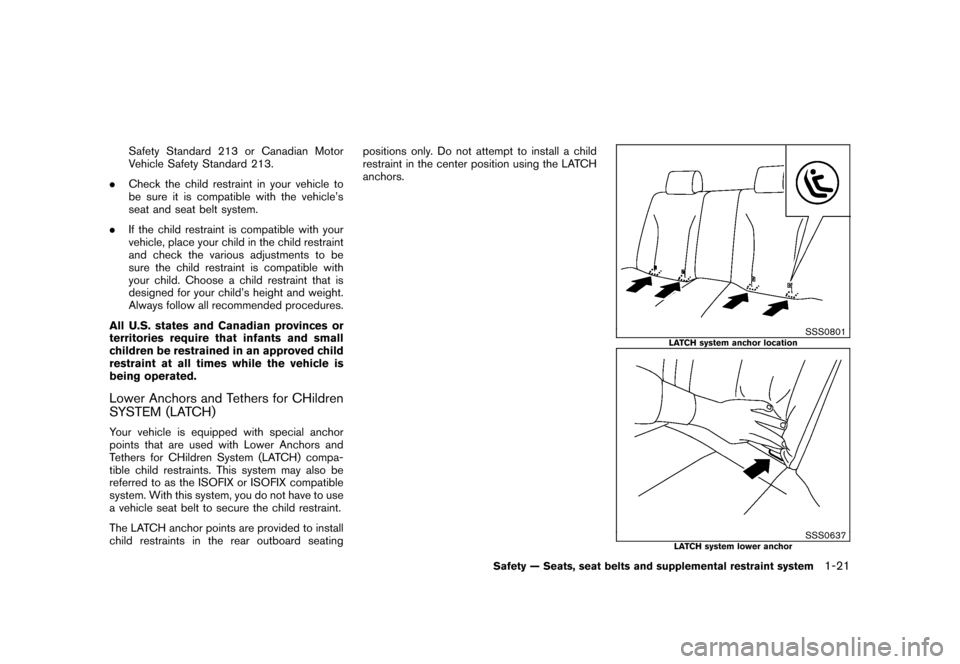
Black plate (33,1)
Model "S35-D" EDITED: 2007/ 12/ 19
Safety Standard 213 or Canadian Motor
Vehicle Safety Standard 213.
.Check the child restraint in your vehicle to
be sure it is compatible with the vehicle’s
seat and seat belt system.
.If the child restraint is compatible with your
vehicle, place your child in the child restraint
and check the various adjustments to be
sure the child restraint is compatible with
your child. Choose a child restraint that is
designed for your child’s height and weight.
Always follow all recommended procedures.
All U.S. states and Canadian provinces or
territories require that infants and small
children be restrained in an approved child
restraint at all times while the vehicle is
being operated.
Lower Anchors and Tethers for CHildren
SYSTEM (LATCH)Your vehicle is equipped with special anchor
points that are used with Lower Anchors and
Tethers for CHildren System (LATCH) compa-
tible child restraints. This system may also be
referred to as the ISOFIX or ISOFIX compatible
system. With this system, you do not have to use
a vehicle seat belt to secure the child restraint.
The LATCH anchor points are provided to install
child restraints in the rear outboard seatingpositions only. Do not attempt to install a child
restraint in the center position using the LATCH
anchors.
SSS0801
LATCH system anchor location
SSS0637
LATCH system lower anchor
Safety — Seats, seat belts and supplemental restraint system
1-21
Page 35 of 309
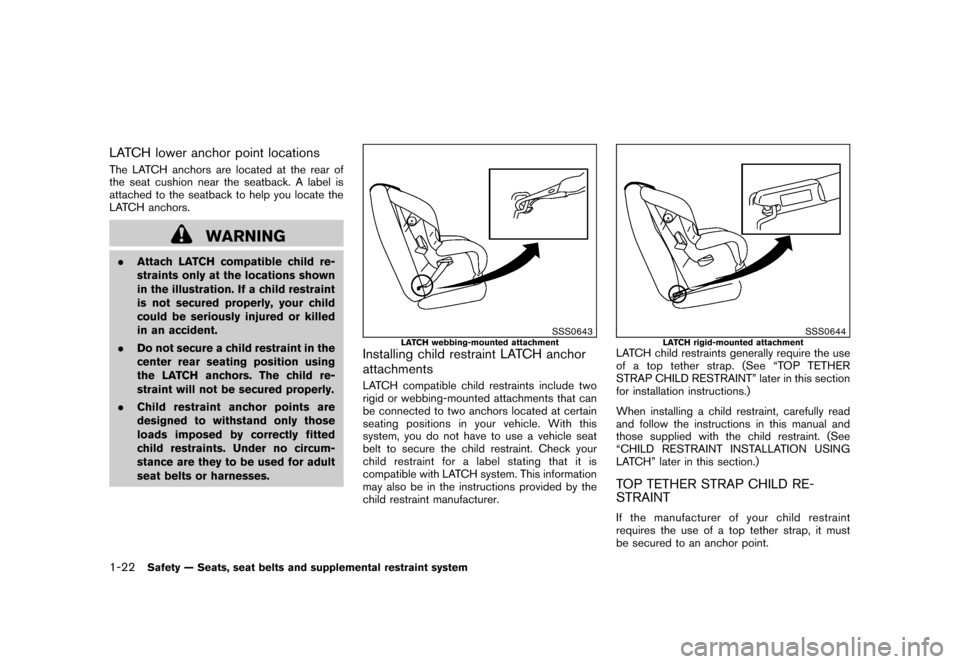
Black plate (34,1)
Model "S35-D" EDITED: 2007/ 12/ 19
LATCH lower anchor point locationsThe LATCH anchors are located at the rear of
the seat cushion near the seatback. A label is
attached to the seatback to help you locate the
LATCH anchors.
WARNING
.Attach LATCH compatible child re-
straints only at the locations shown
in the illustration. If a child restraint
is not secured properly, your child
could be seriously injured or killed
in an accident.
.Do not secure a child restraint in the
center rear seating position using
the LATCH anchors. The child re-
straint will not be secured properly.
.Child restraint anchor points are
designed to withstand only those
loads imposed by correctly fitted
child restraints. Under no circum-
stance are they to be used for adult
seat belts or harnesses.
SSS0643
LATCH webbing-mounted attachment
Installing child restraint LATCH anchor
attachmentsLATCH compatible child restraints include two
rigid or webbing-mounted attachments that can
be connected to two anchors located at certain
seating positions in your vehicle. With this
system, you do not have to use a vehicle seat
belt to secure the child restraint. Check your
child restraint for a label stating that it is
compatible with LATCH system. This information
may also be in the instructions provided by the
child restraint manufacturer.
SSS0644
LATCH rigid-mounted attachment
LATCH child restraints generally require the use
of a top tether strap. (See “TOP TETHER
STRAP CHILD RESTRAINT” later in this section
for installation instructions.)
When installing a child restraint, carefully read
and follow the instructions in this manual and
those supplied with the child restraint. (See
“CHILD RESTRAINT INSTALLATION USING
LATCH” later in this section.)TOP TETHER STRAP CHILD RE-
STRAINTIf the manufacturer of your child restraint
requires the use of a top tether strap, it must
be secured to an anchor point.
1-22
Safety — Seats, seat belts and supplemental restraint system
Page 36 of 309
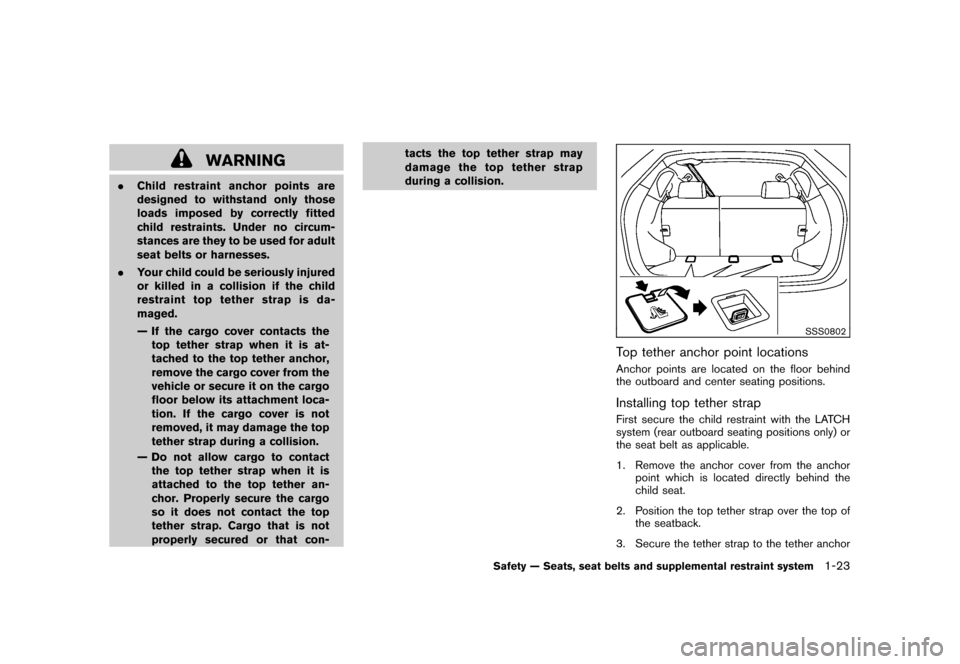
Black plate (35,1)
Model "S35-D" EDITED: 2007/ 12/ 19
WARNING
.Child restraint anchor points are
designed to withstand only those
loads imposed by correctly fitted
child restraints. Under no circum-
stances are they to be used for adult
seat belts or harnesses.
.Your child could be seriously injured
or killed in a collision if the child
restraint top tether strap is da-
maged.
— If the cargo cover contacts the
top tether strap when it is at-
tached to the top tether anchor,
remove the cargo cover from the
vehicle or secure it on the cargo
floor below its attachment loca-
tion. If the cargo cover is not
removed, it may damage the top
tether strap during a collision.
— Do not allow cargo to contact
the top tether strap when it is
attached to the top tether an-
chor. Properly secure the cargo
so it does not contact the top
tether strap. Cargo that is not
properly secured or that con-tacts the top tether strap may
damage the top tether strap
during a collision.
SSS0802
Top tether anchor point locationsAnchor points are located on the floor behind
the outboard and center seating positions.Installing top tether strapFirst secure the child restraint with the LATCH
system (rear outboard seating positions only) or
the seat belt as applicable.
1. Remove the anchor cover from the anchor
point which is located directly behind the
child seat.
2. Position the top tether strap over the top of
the seatback.
3. Secure the tether strap to the tether anchor
Safety — Seats, seat belts and supplemental restraint system
1-23
Page 37 of 309
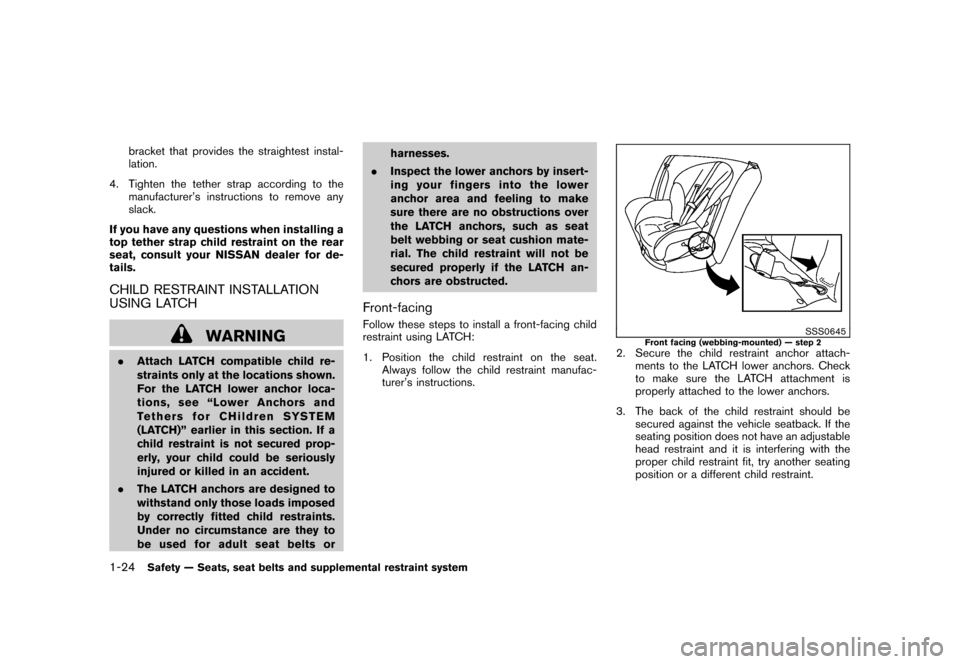
Black plate (36,1)
Model "S35-D" EDITED: 2007/ 12/ 19
bracket that provides the straightest instal-
lation.
4. Tighten the tether strap according to the
manufacturer’s instructions to remove any
slack.
If you have any questions when installing a
top tether strap child restraint on the rear
seat, consult your NISSAN dealer for de-
tails.
CHILD RESTRAINT INSTALLATION
USING LATCH
WARNING
.Attach LATCH compatible child re-
straints only at the locations shown.
For the LATCH lower anchor loca-
tions, see “Lower Anchors and
Tethers for CHildren SYSTEM
(LATCH)” earlier in this section. If a
child restraint is not secured prop-
erly, your child could be seriously
injured or killed in an accident.
.The LATCH anchors are designed to
withstand only those loads imposed
by correctly fitted child restraints.
Under no circumstance are they to
be used for adult seat belts orharnesses.
.Inspect the lower anchors by insert-
ing your fingers into the lower
anchor area and feeling to make
sure there are no obstructions over
the LATCH anchors, such as seat
belt webbing or seat cushion mate-
rial. The child restraint will not be
secured properly if the LATCH an-
chors are obstructed.
Front-facingFollow these steps to install a front-facing child
restraint using LATCH:
1. Position the child restraint on the seat.
Always follow the child restraint manufac-
turer’s instructions.
SSS0645
Front facing (webbing-mounted) — step 2
2. Secure the child restraint anchor attach-
ments to the LATCH lower anchors. Check
to make sure the LATCH attachment is
properly attached to the lower anchors.
3. The back of the child restraint should be
secured against the vehicle seatback. If the
seating position does not have an adjustable
head restraint and it is interfering with the
proper child restraint fit, try another seating
position or a different child restraint.
1-24
Safety — Seats, seat belts and supplemental restraint system
Page 38 of 309

Black plate (37,1)
Model "S35-D" EDITED: 2007/ 12/ 19
SSS0646
Front facing (rigid-mounted) — step 2
SSS0647
Front facing — step 4
4. For child restraints that are equipped with
webbing-mounted attachments, remove any
additional slack from the anchor attach-
ments. Press downward and rearward firmly
in the center of the child restraint with your
knee to compress the vehicle seat cushion
and seatback while tightening the webbing
of the anchor attachments.
5. If the child restraint is equipped with a top
tether strap, route the top tether strap and
secure the tether strap to the tether anchor
point. (See “TOP TETHER STRAP CHILD
RESTRAINT” earlier in this section.)
SSS0638
Front facing — step 6
6. Before placing the child in the child restraint,
hold child restraint near the LATCH attach-
mentanduseforcetopushthechild
restraint from side to side, and tug it forward
to make sure that it is securely held in place.
It should not move more than 1 in (25 mm) . If
it does move more than 1 in (25 mm) , pull
again on the anchor attachments to further
tighten the child restraint. If you are unable
to properly secure the restraint, move the
restraint to another seating position and try
again, or try a different child restraint. Not all
child restraints fit in all types of vehicles.
Safety — Seats, seat belts and supplemental restraint system
1-25
Page 39 of 309
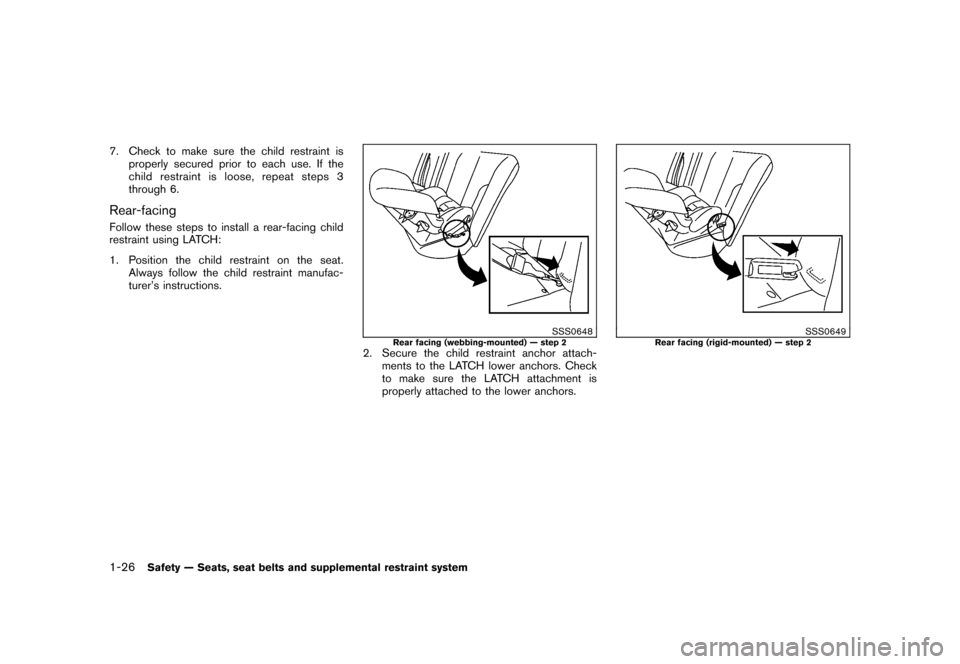
Black plate (38,1)
Model "S35-D" EDITED: 2007/ 12/ 19
7. Check to make sure the child restraint is
properly secured prior to each use. If the
child restraint is loose, repeat steps 3
through 6.Rear-facingFollow these steps to install a rear-facing child
restraint using LATCH:
1. Position the child restraint on the seat.
Always follow the child restraint manufac-
turer’s instructions.
SSS0648
Rear facing (webbing-mounted) — step 2
2. Secure the child restraint anchor attach-
ments to the LATCH lower anchors. Check
to make sure the LATCH attachment is
properly attached to the lower anchors.
SSS0649
Rear facing (rigid-mounted) — step 2
1-26
Safety — Seats, seat belts and supplemental restraint system
Page 40 of 309
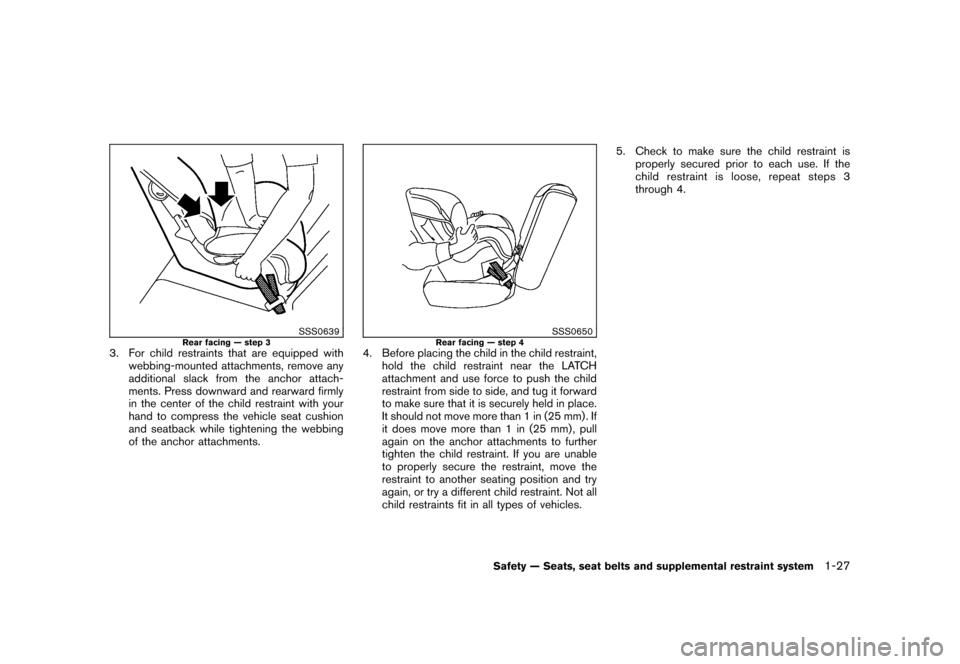
Black plate (39,1)
Model "S35-D" EDITED: 2007/ 12/ 19
SSS0639
Rear facing — step 3
3. For child restraints that are equipped with
webbing-mounted attachments, remove any
additional slack from the anchor attach-
ments. Press downward and rearward firmly
in the center of the child restraint with your
hand to compress the vehicle seat cushion
and seatback while tightening the webbing
of the anchor attachments.
SSS0650
Rear facing — step 4
4. Before placing the child in the child restraint,
hold the child restraint near the LATCH
attachment and use force to push the child
restraint from side to side, and tug it forward
to make sure that it is securely held in place.
It should not move more than 1 in (25 mm) . If
it does move more than 1 in (25 mm) , pull
again on the anchor attachments to further
tighten the child restraint. If you are unable
to properly secure the restraint, move the
restraint to another seating position and try
again, or try a different child restraint. Not all
child restraints fit in all types of vehicles.5. Check to make sure the child restraint is
properly secured prior to each use. If the
child restraint is loose, repeat steps 3
through 4.
Safety — Seats, seat belts and supplemental restraint system
1-27